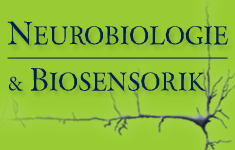|
|
||
|
Dr. Cornelia Voß , geb. Hagemann
Sensory organs enable mammals to identify and analyse their environment. While the sense of vision dominates the cognitive capabilities of most mammals and humans, bats (Microchiroptera) possess the exceptional ability to orientate themselves in complete darkness with the help of echolocation. These echolocation or echo perception capabilities require bats to have an extremely well-developed auditory system. Bats achieve these capabilities by hypertrophy of the auditory system, while the composition of their sound processing centre is not fundamentally different from other mammals not using echolocation. The physiology of auditory centres in mammals is already well examined and characterized. However, little is known about the ontogenetic development of the auditory system in bats. Therefore, my research is focused on the maturing process of the auditory system at the cortical level in the FM bat Carollia perspicillata. Similar to analyses of the auditory cortex (AC) in adult animals, the AC is being examined and mapped electrophysiologically in animals across age groups. My focus is on the frequency organization in the auditory cortex during the ontogenesis of Carollia perspicillata.
Other publications have shown for the CF-FM bat Pteronotus parnellii, for example, that the AC can be separated into different areas (primary & secondary cortex) within the first few postnatal weeks. Neurons, which analyse the frequency of the CF-components, are located in the primary auditory cortex. In the CF/CF region there are neurons, which respond to a certain combination of two CF components. In the FM/FM region, neurons respond to certain FM/FM combinations with a defined time interval (delay). With the help of these specific sound-echo delays an efficient acoustic ranging on neural level is guaranteed. Such delay-sensitive neurons are also assumed in the auditory cortex of Carollia perspicillata. In my graduation work I examined the AC of Carollia perspicillata from an electrophysiological perspective and focused on delay sensitive neurons. So the description of the processing mechanism of the auditory cortex in detail is possible. It is interesting that delay sensitive neurons in Pteronotus parnellii are thought to be essential for detecting insects. However, since Carollia perspicillata is a frugivore it may be concluded that delay-tuned neurons are needed for general orientation purposes. Further readings: Eiermann, A., Esser K.-H., (2000): Auditory responses from the frontal cortex in the short-tailed fruit bat Carollia perspicillata. Neuroreport, 11(2):421-5. |
||
| 2011, 2010, 2009 | ||
| Publications 2011
Hagemann, C.; Vater, M.; Kössl, M. (2011) Comparison of properties of cortical echo delay-tuning in the short-tailed fruit bat and the mustached bat. J Comp Physiol A 197:605-613. Voss C., Kössl M. (2011): Postnatal development of delay-sensitive neurons in the auditory cortex of the short-tailed fruit bat. 9th Göttingen Meeting of the German Neuroscience Society: T18-6C
Schlenther D., Voss C., Kössl M. (2011): Cubic and quadratic distortion-product otoacoustic emissions (DPOAE) in awake and anesthetized short-tailed fruit bats. 9th Göttingen Meeting of the German Neuroscience Society: T17-6A |
||
| Publications Top | ||
| Publikation 2010
Hagemann, C; Esser, K.H.; Kössl, M. (2010) A chronotopically organized target-distance map in the auditory cortex of the Short-tailed Fruit Bat. J Neurophysiol 103:322-333. Hagemann, C; Kössl, M. (2010) Postnatal development of frequency-representation in the auditory cortex of the Short-Tailed Fruit Bat. FNES Abstract 5, 112.20. |
||
| Publications Top | ||
| Publications 2009
Hagemann, C.; Esser, K.H.; Kössl, M. (2009): Kössl, M.; Hagemann, C.; Foeller, E.; Mora, E.; Macias, S.; Vater, M. (2009): Hagemann, C.; Esser, K.H.; Kössl, M. (2009): Müller, B.; Glösmann, M.; Peichl, L.; Knop, G.C.; Hagemann, C.; Ammermüller, J. (2009): |
||
| Publications Top |
FB15
Arbeitskreis Neurobiologie und Biosensorik
Institut für Zellbiologie und Neurowissenschaft
Biologicum, Campus Riedberg
Gebäudeteil A, 3. Stock
Max-von-Laue-Str. 13
60438 Frankfurt am Main
T +49 69 798-42050
E-Mail
- Studying at Goethe University
- International applicants
- Faculties
- Overview of study programmes
- Programme for refugees
- GRADE
- Goethe Business School (continuing education)
- Research at Goethe University
- Scientific news
- Goethe Welcome Center (for international researchers)
- Collaborative research projects
- Individual research
- Visiting fellowships
- Endowed chairs
- About the University
- News-in-brief
- University administration
- Campus locations
- Campus life
- University archives (German)
- Rhine-Main-Universities






